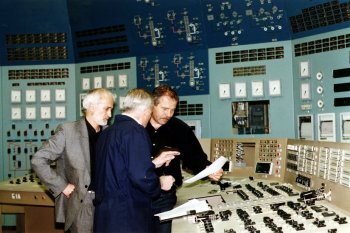![]()
Improving the Safety of Day-to-Day Operations
Training Partnerships Build Skills and Safety Awareness
|
US Dept. of Energy Office of International Nuclear Safety and Cooperation 1000 Independence Ave S.W. Washington, DC 20585 (202) 586-6641 https://insp.pnnl.gov:2080/ |
Well-trained, safety-conscious workers are essential for safe operation of a nuclear power plant. Experts from the United States have collaborated with Russian and Ukrainian specialists to establish nuclear training centers at Russia's Balakovo plant and Ukraine's Khmelnytskyy plant. U.S. experts also are working with instructors at Soviet-designed plants in Bulgaria, Lithuania, Slovakia, and Armenia to improve training. From 1994 to 1999, the training centers in Russia and Ukraine developed and conducted courses covering
Instructors at the Balakovo and Khmelnytskyy centers completed extensive course work in the Systematic Approach to Training, a methodology adopted at all U.S. nuclear power plants after the 1979 accident at Three Mile Island. This approach provides a standard framework for identifying training needs, analyzing jobs and their associated tasks, developing courses based on these analyses, and using teaching methods that combine classroom instruction with hands-on equipment use. The United States provided basic equipment for the training centers, such as computers, software, and copiers. The United States also supplied specialized equipment for the pilot courses, such as soldering stations and laser alignment equipment. The Balakovo and Khmelnytskyy training centers have developed additional course materials, expanding their training programs beyond the work sponsored by the United States. Together, the two centers have trained more than 4,000 workers from Soviet-designed nuclear power plants. Both training staffs have evaluated their programs, developing performance indicators and an evaluation methodology. In 1997, staff from the training centers began teaching instructors at other plants to improve their training processes. U.S. experts have provided support. Host-country and U.S. specialists conducted a training needs analysis, then worked with instructors at each plant in Russia and Ukraine to develop and present a pilot course, using the Systematic Approach to Training. Each course covered one of the following topics: mechanical maintenance of rotating equipment, calibration and repair of pressure transmitters, integrated circuit board repair, maintenance of sodium system components, and skills for shift supervisors and chemical operators. The courses were presented in 1997 and 1998. Instructors at each plant now are developing additional courses as part of the second phase of the expanded training program. In Bulgaria, U.S. experts worked with instructors at the Kozloduy training center to develop and present three courses in 1998. Topics included management and supervisory skills, control-room operator skills, and the development of a safety-oriented culture. In Slovakia, U.S. specialists conducted a training needs assessment at the Bohunice plant and the Trnava Training Center, then worked with Trnava staff to develop a pilot course in training methodologies. Trnava instructors presented this course in 1998. In Lithuania, the United States is working with the International Atomic Energy Agency to improve training at the Ignalina plant. In 1998, instructors from Ignalina completed a four-week course in the Systematic Approach to Training. They will conduct a pilot course for control room operators in 1999. The United States also is working with the International Atomic Energy Agency to improve training at the Armenia Nuclear Power Plant, where instructors are developing a pilot course for control room operators. |
